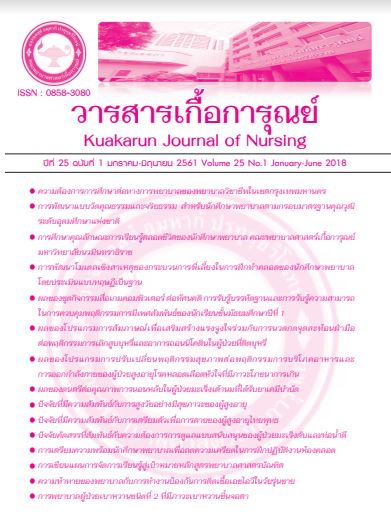ผลของโปรแกรมการสัมภาษณ์เพื่อเสริมสร้างแรงจูงใจร่วมกับ การนวดกดจุดสะท้อนฝ่ามือต่อพฤติกรรมการเลิกสูบบุหรี่ และอาการถอนนิโคตินในผู้ป่วยที่ติดบุหรี่
คำสำคัญ:
การสัมภาษณ์เพื่อเสริมสร้างแรงจูงใจ, การนวดกดจุดสะท้อนฝ่ามือ, พฤติกรรม การเลิกสูบบุหรี่, อาการถอนนิโคติน, การติดบุหรี่บทคัดย่อ
This experimental research was a two group pretest-posttest design. The research aimed to evaluate the effect of Motivational Interviewing combined with hand reflexology on quit smoking behavior and nicotine withdrawal symptoms in tobacco addicted patients. The study sample were 40 tobacco addicted patients at the outpatient clinics of medical and surgical departments, Faculty of Medicine Vajira Hospital, Navamindradhiraj University. They were selected by purposive sampling method and randomly divided into 2 groups of experimental and control with equal number. Data were collected by using general information questionnaire, quit smoking behavior questionnaire, nicotine
withdrawal symptoms questionnaire and cotinine in urine test (nicotine). The program consisted of the Motivational Interviewing, teaching and
demonstrating hand reflexology to relatives of patients recording in hand reflexology record form. The researcher assessed nicotine withdrawal symptoms post smoking cessation on day 1, 3 and 7 by telephone. Descriptive statistics, Paired sample t-test, Independent t-test, Repeated Measures ANOVA (Pairwise comparison) and Pearson Chi-square were used to analyse the data.The results showed that the mean scores of quit smoking behavior in both groups before participating the program were not significantly different (p > 0.05), but after participating the program the mean scores of quit smoking behavior of the experimental group were significantly higher than before participating the program and higher than the control group (p < 0.05). Mean scores of nicotine withdrawal symptoms post smoking cessation on day 1, 3 and 7 were reduced
sequentially with statistical significance (p < 0.05). Number of the experimental group who had cotinine in urine were significantly less than before participating the program and less than those of the control group (p < 0.05).















